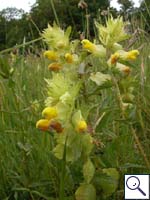|
||||||
|
RHINANTHUS. Yellow-rattles. [Scrophulariaceae] |
|
|
Two species of Rhinanthus, Greater Yellow-rattle (R. angustifolius) and Yellow-rattle (R. minor) are recorded in Britain. Both are native. Greater Yellow-rattle (R. angustifolius) is protected under Schedule 8 of the Wildlife and Countryside Act, 1981. Two British miners are recorded on Rhinanthus. A key to the European miners recorded on Rhinanthus is provided in Bladmineerders van Europa. |
|
Key for the identification of the known mines of British |
|
1a > Leaf-miner: Oviposition takes place in an upper leaf and a short mine is formed either in the leaf or stem, but the larva feeds primarily in the stem. Pupating in the stem (Spencer, 1976: 487 (fig. 857), 488). Short and narrow corridor in the leaves, bracts or even calyx, ending in a thick vein. From there the larva descends as a borer. Infested plants largely die off. Pupation and hibernation within the mine. |
|
|
|
Phytomyza rostrata Hering, 1934 [Diptera: Agromyzidae]. |
|
| 1b > Leaf-miner: Rather long full depth corridor that winds freely through the leaf and may cross itself. In the end the corridor widens considerably. Frass mostly in a narrow central line, but may also be deposited along the sides or be missing. The larvae regular leave a mine to restart elsewhere. Pupation outside the mine. Neither larva or mine can be distinguished from that of related species. | |
|
|
Apteropeda orbiculata (Marsham, 1802) [Coleoptera: Chrysomelidae]. |
|
| Last updated 06-Jul-2019 Brian Pitkin | ||

